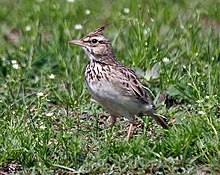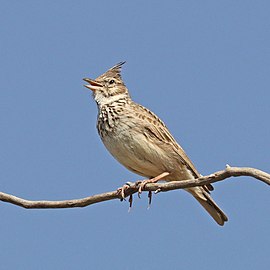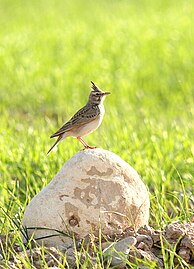
The horned lark or shore lark is a species of lark in the family Alaudidae found across the northern hemisphere. It is known as "horned lark" in North America and "shore lark" in Europe.

The calandra lark or European calandra-lark breeds in warm temperate countries around the Mediterranean and eastwards through Turkey into northern Iran and southern Russia. It is replaced further east by its relative, the bimaculated lark.

Thekla's lark, also known as the Thekla lark, is a species of lark that breeds on the Iberian Peninsula, in northern Africa, and sub-Saharan Africa from Senegal to Somalia. It is a sedentary (non-migratory) species. This is a common bird of dry open country, often at some altitude. Thekla's lark was named by Alfred Edmund Brehm in 1857 for his recently deceased sister Thekla Brehm (1833–1857). The name is a modern Greek one, Θέκλα, which comes from ancient Greek Θεόκλεια (Theokleia) derived from θεός and κλέος. The population is declining in Spain, but this is a common bird with a very wide range and the International Union for Conservation of Nature has rated its conservation status as being of "least concern".

The Malabar lark, or Malabar crested lark is a species of lark in the family Alaudidae found in western India.
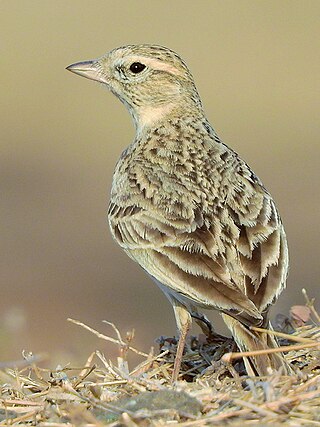
The greater short-toed lark is a small passerine bird. The current scientific name is from Ancient Greek. The genus name, Calandrella, is a diminutive of kalandros, the calandra lark, and brachydactila is from brakhus, "short", and daktulos, "toe".

The Mediterraneanshort-toed lark is a small passerine bird found in and around the Mediterranean Basin. It is a common bird with a very wide range from Canary Islands north to the Iberian Peninsula and east throughout North Africa to parts of the Middle East. The International Union for Conservation of Nature has rated its conservation status as being of "least concern".
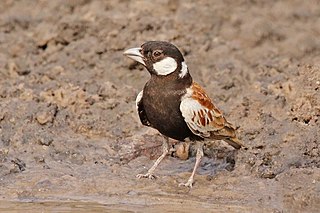
The chestnut-backed sparrow-lark is a passerine bird which is a resident breeder in Africa south of the Sahara Desert.
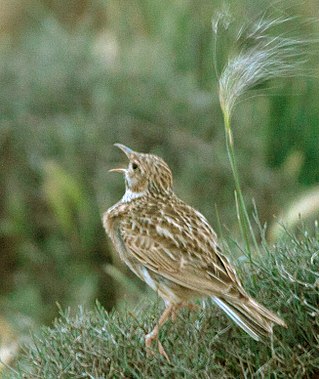
Dupont's lark is a species of lark in the family Alaudidae of the monotypic genus Chersophilus. It is found in northern Africa and Spain.
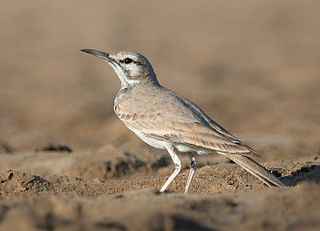
The greater hoopoe-lark is a passerine bird which is a breeding resident of arid, desert and semi-desert regions from the Cape Verde Islands across much of northern Africa, through the Arabian peninsula, Syria, Afghanistan, Pakistan and India. It was formerly known as the bifasciated lark and sometimes as the large desert lark.

The desert lark breeds in deserts and semi-deserts from Morocco to western India. It has a very wide distribution and faces no obvious threats, and surveys have shown that it is slowly increasing in numbers as it expands its range. The International Union for Conservation of Nature has rated its conservation status as being of "least concern".
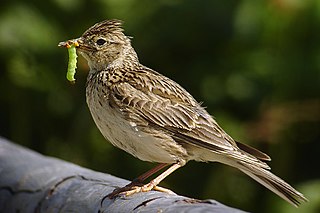
Alauda is a genus of larks found across much of Europe, Asia and in the mountains of north Africa, and one of the species endemic to the islet of Raso in the Cape Verde Islands. Further, at least two additional species are known from the fossil record. The current genus name is from Latin alauda, "lark". Pliny the Elder thought the word was originally of Celtic origin.
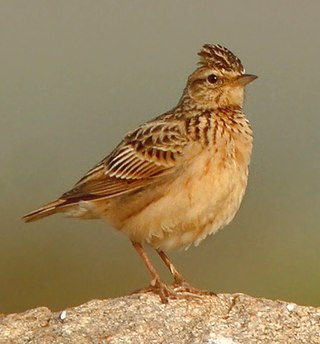
Sykes's lark is a species of lark found in the dry open country of India. Its distribution is mainly restricted to central India, although stray records have been found elsewhere on the sub-continent. It is identified by its prominent crest and its overall rufous colouration. It has streaks on its breast which are less prominent than those found in the Oriental skylark.

The Oriental skylark, also known as the small skylark, is a species of skylark found in the southern, central and eastern Palearctic. Like other skylarks, it is found in open grassland where it feeds on seeds and insects.

The large-billed lark or southern thick-billed lark is a small passerine bird found in southern Africa. The name "large-billed lark" may also refer to Bradfield's lark. The name "thick-billed lark" more commonly refers to the species of the same name.

The flappet lark is a species of lark in the family Alaudidae, widespread across Sub-Saharan Africa. The name flappet originates from the distinctive wing flapping sound made during its breeding season.

The sabota lark is a species of lark in the family Alaudidae. It is found in southern Africa in its natural habitats of dry savannah, moist savannah, and subtropical or tropical dry shrubland. It is generally sedentary but local movements occur in drier regions. The species name is derived from sebotha or sebothé, the Tswana generic name for a lark.

The bar-tailed lark or bar-tailed desert lark is a species of lark in the family Alaudidae. Two other species, the rufous-tailed lark and the Cape clapper lark are both also sometimes referred to using the name bar-tailed lark. It is found from Morocco to Pakistan. Its natural habitat is hot deserts. This is in many places a common species, but elsewhere rather less common. It has a very wide distribution and faces no obvious threats, but surveys have shown that it is slowly decreasing in numbers. The International Union for Conservation of Nature has rated its conservation status as being of "least concern".

The spike-heeled lark is a species of lark in the family Alaudidae. It is found in southern Africa.

The sun lark or Nigerian sun lark, is a species of lark in the family Alaudidae. Its range extends mainly across the Sudan region, from Guinea to South Sudan. Its natural habitats are dry savannah and subtropical or tropical dry lowland grassland.

The Maghreb lark is a species of lark in the family Alaudidae found in the Maghreb desert of north-western Africa.
